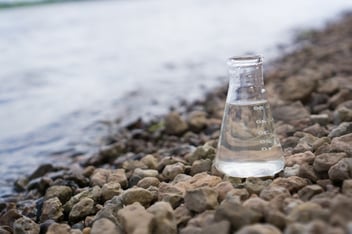'Sludgy ducklings' help utilities tackle a growing problem
By combining basic technology with advanced analytics, a team from the University of Western Australia (UWA) has developed a tool to help utilities better manage sludge.
The Sludge Analytics system is made up of a remote-controlled boat (dubbed the ‘Sludgy Duckling’ by TasWater and ‘Plop-eye’ by SA Water) that navigates wastewater lagoons, using sonar to collect information about depth and asset conditions.
This data is then fed into algorithms that generate analytics water utilities can use for operations, planning and asset management.
“The sonar is very low-tech but the smart part is in the data management system,” UWA Professor of Environmental Engineering Anas Ghadouani said.
“Essentially, the output can be used as an input for further modelling. If you have a much better understanding of the bottom of a wastewater pond, you get more reliable hydrodynamic modelling.”
With the amount of wastewater utilities need to treat increasing, and restrictions on environmental discharges getting stricter, Ghadouani said sludge is a growing issue that is often hard to plan for and expensive to manage.
The research was funded by the Australian Research Council and utilities including Western Australia’s Water Corporation, TasWater, Melbourne Water and SA Water.
“Sludge is a big problem for water utilities, requiring planning and funding to manage and remove it,” Ghadouani said.
“Understanding sludge distribution, accumulation rates and the dynamics of how sludge moves within a system means utilities can design systems that are less prone to short circuiting.
“At the end of the day, you want every drop of water exposed to the same level of treatment – that’s the Holy Grail.”
An industry-led solution
Sludge Analytics was nine years in the making, with much of this time spent collaborating with the water industry to find out exactly what was needed from the tool.
One of the main outcomes was removing the safety risk posed by traditional sludge measurement practices, where operators need to be out on the water.
“We started by having conversations about how to develop a better understanding of sludge accumulation in wastewater ponds,” said Sludge Analytics project manager Dr Liah Coggins.
“Then we collaborated with a number of utilities to learn more about their specific requirements when it comes to data analysis.”
Today, Sludge Analytics is in its seventh iteration, having evolved from a simple model that could collect a few thousand data points to a sophisticated algorithm that can assess data sets with more than 2 million data points.
The system is cloud-based and allows users to perform various diagnostics anywhere, whether it’s on-site, in a lab or an office.
The next stage is to integrate Sludge Analytics into the dashboard systems utilities already have and to get the software to smaller utilities. Ghadouani and Coggins said they also plan to keep the conversation going with the industry.
“We could never have done it by ourselves,” Ghadouani said.
“We had the concept, but this was only a small fraction of the success.”



